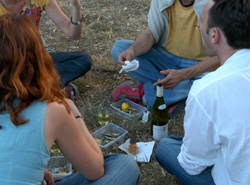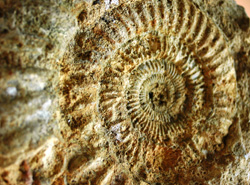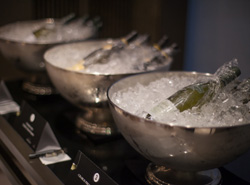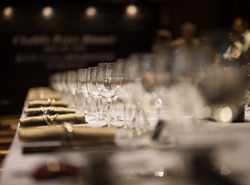Chablis wines are dry white wines which are characterized by their purity, crispness, sophistication and minerality. The Chardonnay varietal gives results in Chablis unlike anywhere else. It draws its personality and character from a subsoil that is 150 million years old, and ripens in ideal conditions, in a semi-continental climate, which allow it to attain a good balance between sugar levels and acidity.Today, the area planted in Chablis is just over 5,400ha. In 1955, after the phylloxera crisis in the 19th century which ravaged France's vineyards, then two world wars, Chablis covered no more than 550ha of vine. Nonetheless, not all the appellation's territory is planted as yet: the delimited zone comprises 6,800ha spreading along the valley of the Serein, the river which runs through the wine region from south to north before flowing into the Yonne.These are identified by precisely delimited production zones, and are subject to strict production regulations. Logically, the higher up the hierarchy, the tighter these regulations.
The volumes produced have changed in accordance with the increase in area cultivated, with minor variations due to climatic vagaries. In 2014, the harvest amounted to slightly over 308,000hl, the equivalent of 40 million bottles. Vinification covers all the procedures of winemaking, whether mechanical, microbiological or biochemical. While the quality of the wine depends on the terroir, it also depends on the quality of the harvest, respect for hygiene, and the techniques employed during vinification.
From its arrival at the winery, the harvest is taken to the press. The must obtained is then transferred either to oak barrels or stainless-steel vats for the alcoholic fermentation to begin. This continues for about three weeks at low temperature (between 15-18°C). During this stage, the yeasts transform the sugar in the grapes into alcohol.
Once alcoholic fermentation is finished, a secondary fermentation known as "malolactic" is triggered: lactic bacteria turn the malic acid naturally present in the wine into lactic acid. This process reduces the acidity of the wine and stabilizes it. The majority of Chablis wines undergo this secondary fermentation.
Next comes ageing, which is done either in vats or barrels, depending on the type of wine desired.
Next comes ageing, which is done either in vats or barrels, depending on the type of wine desired.
This period varies according to the winemaker's approach and the profile of the wine sought. For the Chablis Grand Cru appellation, ageing must continue until at least 15 March of the year following the harvest. Then blending can be carried out to obtain wines with a better balance, depending on the style of wine and ageing potential the winemaker is looking for.
One particularity of Chablis is that oak barrels are used only sparingly, and chiefly for the appellations Chablis Premier Cru and Chablis Grand Cru, although not always. The proportion of new barrels is often quite low, in order to preserve the expression of the terroir. This practice has ancient origins: traditionally, the wines from Chablis were delivered in barrels by boat to Paris, then these barrels returned empty to Chablis to be filled again. So there is no tradition of new oak in Chablis. By contrast, in Meursault, the barrels of wine were not returned after delivery, so the winemakers would always use new ones, and today they continue to use new oak in Meursault.
Here is a link to how they make wine in Burgundy. Note that they do not necessary do all these steps in Chablis.
To serve a wine correctly, it must be at the right temperature. For a Petit Chablis, the ideal temperature is around 8°C to serve as an aperitif and 9-10°C with food. Chablis and Chablis Premier Cru should be served at 10-11°C, and Chablis Grand Cru at 12-14°C.
From Petit Chablis to Chablis Grand Cru, the wines of Chablis offer a wide range of aromatic profiles and expressions to suit simple gatherings among friends or more formal occasions.
There is a Chablis wine to suit every occasion!
There is a Chablis wine to suit every occasion!
 Despite being produced far from the sea, Petit Chablis nonetheless offers lovely whiffs of the seashore that go perfectly with oysters, mussels, raw fish dishes and shrimps, either raw, barbecued or in sauce. It is also delightful with fried small river fish, grilled sardines and many other fish. But it is its vivaciousness that is most tempting. For fried eggs and omelets, Petit Chablis is the perfect master, capable of balancing out any heaviness they may bring. It is also ideal with andouillette and snails. Goat cheeses are also perfectly at ease with its well-structured charms, without forgetting hard cheeses like Gouda and Gruyère. Its crispness offers a simple accompaniment for summer salads, quiches, aperitifs served with gougères or for moments shared with friends.
Despite being produced far from the sea, Petit Chablis nonetheless offers lovely whiffs of the seashore that go perfectly with oysters, mussels, raw fish dishes and shrimps, either raw, barbecued or in sauce. It is also delightful with fried small river fish, grilled sardines and many other fish. But it is its vivaciousness that is most tempting. For fried eggs and omelets, Petit Chablis is the perfect master, capable of balancing out any heaviness they may bring. It is also ideal with andouillette and snails. Goat cheeses are also perfectly at ease with its well-structured charms, without forgetting hard cheeses like Gouda and Gruyère. Its crispness offers a simple accompaniment for summer salads, quiches, aperitifs served with gougères or for moments shared with friends. The wines of Chablis awaken the senses and revive the tastebuds. This makes them ideal for enjoying as an aperitif or with seafood or oysters. But that’s not all! This unique wine can be enjoyed young, aged two or three years, with fish or fowl terrines or with grilled or poached fish. But also with asparagus - a tough dish to match with a wine - or with world cuisine, tandoori or other curry dishes. Chablis is also a perfect balancing act with the melting texture and subtle flavor of sushi. The depth of a Chablis enhances Swiss cheese, aged goat cheese, Beaufort, Comté, Emmental and vintage Cheddar. It is also a wonderful partner for grilled white fish or roast chicken.
The wines of Chablis awaken the senses and revive the tastebuds. This makes them ideal for enjoying as an aperitif or with seafood or oysters. But that’s not all! This unique wine can be enjoyed young, aged two or three years, with fish or fowl terrines or with grilled or poached fish. But also with asparagus - a tough dish to match with a wine - or with world cuisine, tandoori or other curry dishes. Chablis is also a perfect balancing act with the melting texture and subtle flavor of sushi. The depth of a Chablis enhances Swiss cheese, aged goat cheese, Beaufort, Comté, Emmental and vintage Cheddar. It is also a wonderful partner for grilled white fish or roast chicken. The Chablis Premier Cru appellation brings together a wide range of small terroirs and Climats, that express themselves through the Chardonnay varietal. The great aromatic richness of the wines of Chablis Premier Cru means they are perfect for a wide range of combinations such as cooked oysters or fish in sauce. Those more mineral wines are delicious with poultry dishes or veal in white sauce. The more open crus are wonderful as an accompaniment to andouillettes or snails. A full-bodied example would be a perfect match for a local specialty such as ham in Chablis. These wines also make a great match with hard cheeses and local Bourgogne varieties such as Epoisses. But they also marry wonderfully with hot asparagus, rabbit or crab, scallops and poached fish.
The Chablis Premier Cru appellation brings together a wide range of small terroirs and Climats, that express themselves through the Chardonnay varietal. The great aromatic richness of the wines of Chablis Premier Cru means they are perfect for a wide range of combinations such as cooked oysters or fish in sauce. Those more mineral wines are delicious with poultry dishes or veal in white sauce. The more open crus are wonderful as an accompaniment to andouillettes or snails. A full-bodied example would be a perfect match for a local specialty such as ham in Chablis. These wines also make a great match with hard cheeses and local Bourgogne varieties such as Epoisses. But they also marry wonderfully with hot asparagus, rabbit or crab, scallops and poached fish. The rich and intense liveliness of a Chablis Grand Cru is perfect to bring out all the flavors of foie gras, its intense minerality compensating for the strong taste of this noble dish. The complex subtlety of its aromas and its persistent finish make it a classy partner for grilled lobster or spiny lobster, or more delicate preparations in white sauce, with or without mushrooms, and also with crayfish. All delicate fish dishes in creamy sauces are simply calling out for a Chablis Grand Cru, as well as white meats and poultry, also served in cream sauces. Its crisp mineral side also makes it a wonderful accompaniment for the fresh sea taste of oysters.
The rich and intense liveliness of a Chablis Grand Cru is perfect to bring out all the flavors of foie gras, its intense minerality compensating for the strong taste of this noble dish. The complex subtlety of its aromas and its persistent finish make it a classy partner for grilled lobster or spiny lobster, or more delicate preparations in white sauce, with or without mushrooms, and also with crayfish. All delicate fish dishes in creamy sauces are simply calling out for a Chablis Grand Cru, as well as white meats and poultry, also served in cream sauces. Its crisp mineral side also makes it a wonderful accompaniment for the fresh sea taste of oysters.
Comments